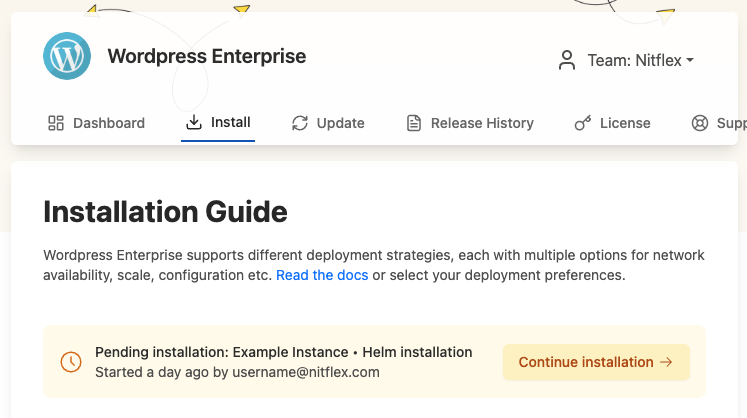Access and Use the Enterprise Portal
This topic describes how to access and use the Enterprise Portal.
Access the Enterprise Portal
To access the Enterprise Portal for a customer:
-
In the Vendor Portal, go to Customers > [Customer Name] > Enterprise Portal Access.
-
Ensure that the Enterprise Portal access toggle is enabled.
-
Do one of the following to log in to the Enterprise Portal:
- Existing user: Click View customer's portal link. In the dialog, enter the email address for the existing Enterprise Portal user and click Continue with email. The Vendor Portal generates a verification code and sends it to the user's email address.
- New user: To log in to the Enterprise Portal as a new user, invite the user and then follow the login link provided in the invitation email. See Invite Users to the Enterprise Portal.
View Install and Update Instructions
This section describes how to view install and update instructions in the Enterprise Portal.
The install and update instructions available in the Enterprise Portal are automatically generated based on the install types and options enabled in the customer's license. For more information about managing the installation types and options, see Manage Install Types for a License.
View Install Instructions
To view install instructions in the Enterprise Portal:
-
Log in to the Enterprise Portal and go to Install.
-
On the panel on the left, select the installation type. The installation options available in the Enterprise Portal are based on the customer's license. For more information, see Manage Install Types for a License.
-
Follow the instructions provided to install.
If you exit the Enterprise Portal before completing the installation, you can resume the installation process by clicking Continue installation on the Install page, as shown below:

View Update Instructions
To view update instructions in the Enterprise Portal:
-
Log in to the Enterprise Portal and go to Update.
For any online instances, the Enterprise Portal displays an Update available button when a new version is available.
-
If an Update available button is displayed, click it to view and follow the update instructions for the given instance.
View Active and Inactive Instances
Users can view their active and inactive instances in the Enterprise Portal, including the instance status and other details.
To view instances in the Enterprise Portal:
-
In the Enterprise Portal, go to Updates.
-
Under Active Instances view details about the active instances. Select View inactive instances to view details about inactive instances.
View Release History
To view the release history in the Enterprise Portal:
-
In the Enterprise Portal, go to Release History.
-
In the Version History panel on the left, select a version to view details about the given release.
View License Details
Customers can view license information, including expiration dates and available features.
To manage licenses in the Enterprise Portal:
-
In the Enterprise Portal, go to License.
-
Under License Details, view license information including the expiration date, status, associated release channels, custom license fields, and more.
Manage Team Settings
This section includes information about how to manage users and service accounts in the Enterprise Portal.
Manage Users
Customers can invite additional users to the portal and manage their access.
To manage invite and manage users in the Enterprise Portal:
-
In the Enterprise Portal, openthe user account dropdown in the top right of the page and select Team settings.
-
Click Users.
-
Manage users as desired:
- To invite a new user, click Invite user.
- To delete a user, find the target user in the table and open the menu. Select Delete user.
Manage Service Accounts
To manage service accounts in the Enterprise Portal:
-
In the Enterprise Portal, openthe user account dropdown in the top right of the page and select Team settings.
-
Click Service accounts.
-
Manage service accounts as desired:
- To create a new service account, click Create Service Account.
- To view a service account token, find the target service account in the table and click View under Token.
- The revoke a service account's token, find the target service account in the table and open the menu under Actions. Select Revoke.
Manage User Settings
Each user can manage their settings in the Enterprise Portal, including enabling and disabling email notifications for various system events.
To manage user settings in the Enterprise Portal:
-
In the Enterprise Portal, open the user account dropdown in the top right of the page and select User settings.
-
Edit the user settings as desired:
- Edit profile information
- Manage email notification preferences
Collect, Upload, and Manage Support Bundles
End customers can use the portal to collect, upload, and manage support bundles.
To manage support bundles in the Enterprise Portal:
-
In the Enterprise Portal, go to Support.
-
Manage support bundles as desired:
-
For Support Bundle Collection, follow the instructions provided to collect a support bundle based on the environment.
-
To upload a support bundle, click Upload support bundle.
-
To view, download, or delete previous support bundles, select Download or Delete in the Support Bundles table.
-